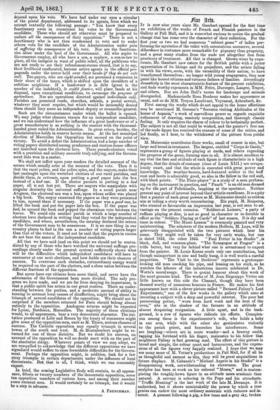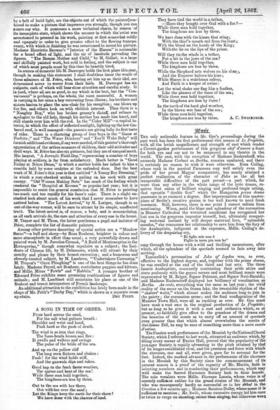fun arts.
IT is now nine years since Mr. Gambart opened for the first time an exhibition of the works of French and Flemish painters in the Gallery at Pall Mall, and it is somewhat carious to notice the gradual change that has come over the character of their collection. For the first year or two we had numerous "cabinet gems" of ladies per- forming the mysteries of the toilet with ostentatious unreserve, several dibardeurs in costumes more remarkable for piquancy than propriety, and a great many studies from the nude not altogether free from pruriency of treatment. All that is changed. Grown wiser by expe- rience, Mr. Gambart now caters for the British public with a juster appreciation of its likings and its prejudices, and the artists falling in with his views, seem, with the versatility of their nation, to have transformed themselves : no longer wild young scapegraces, they now paint like honest citizens and virtuous fathers of families. Accordingly domesticity is the most characteristic feature of the present exhibition, and finds worthy exponents in MM. Frere, Duverger, Lance, Trayer, and others. Nor are John Bull's tastes for landscape and animals disregarded. Mademoiselle Rosa Bonheur makes her appearance as usual, and so do MM. Troyon Lambinet, Veyrassat, Achenba.ch, &c.
First among the works which do not appeal to the home affections may be mentioned M. Gerome's "Socrates visiting Alcibiades at the house of Aspa.sia," a work of marvellous power as regards exquisite refinement. of drawing, masterly composition, and thorough classic feeling. It only requires the charm of colour to be technically perfect. The subject is not all that could be wished, and the painter's free use of the nude figure has received the censure of some of the critics, and led finally, as I hear, to the withdrawal of the picture from public view.
M. Meissonier contributes three works, small of course in size, but large and broad in treatment. The largest, entitled "Corps de Garde," represents a group of figures playing at cards, and others regarding the progress of the game, forming nine in all. It is almost needless to say that the face and attitude of each figure is characteristic in a high degree, that the details of costume (time of Louis XIII.) are scrupu- lously exact, and that the whole is executed with great power and knowledge. The weather-beaten, hard-featured soldier in the buff coat and boots is admirably good, so also is the fellow in the red suit, with black points. "The Flute-player" is a study of a man perform- ing on the instrument in question, and " Punch " is an old man dressed up for thin part of Polichinelle, laughing at the spectator. Neither present any point of interest beyond their artistic excellence. It is a pity that a painter of such great powers. as M. Meissonier should so seldom aim at telling a story worth remembering. His pupil, M. Ruiperez, who created so favourable an impression last year, is not seen to ad- vantage on the present occasion. "Soldiers at Leisure," a party of ruffians playing at dice, is not so good in character or so forcible in effect as the "Soldiers Playing at Cards" of last season. It is dry and tame in colour. "The Music Lesson" is commonly painted and very uninteresting. The admirers of the modern Holbein, M. Leys, will be grievously disappointed with the two pictures which hear his name. They might well be taken for very early works, but one is dated 1852, the other 1853. "Paul Potter in his Studio" is black, dull, and common-place. "The Synagogue at Prague" is a trifle better, but very far behind what one is accustomed to expect from the painter. M. Louis Knew sends only one contribution, but though unimportant in size and badly hung, it is well worth a careful inspection. "The Visit to the Beehives" represents a grotesque- looking old man smoking his pipe, and leaning on his stick, as he watches the labours of the industrious insects celebrated in Dr. Watts's moral songs. There is quaint humour about this work of the most genuine kind. The works of M. Jean Hegesippe Vetter are little known on this side the Channel, though they have been deemed worthy of numerous honours in France. He makes his first appearance here with a clever picture called "Bernard Palissy's Last Experiments," one of the few works in the gallery which aims at investing a subject with a deep and powerful interest. The poor but persevering potter, "worn from hard work and the heat of the oven," sits in the shadow of the furnace in an attitude of almost despairing resignation. A little apart, and in the back- ground, is a row of figures who ridicule his efforts. Conspicu- ous among them is the experimenter's wife, who holds a baby in one arm, while with the other she gesticulates violently to the parish priest, and beseeches his interference. Some are laughing—others are in mute wonder—and a brawny smith, tapping his forehead with his finger, insinuates to his fellow that neighbour Pam, is fast growing mad. The effect of this picture is broad and simple, the colour quiet and harmonious, and the expres- sions of all the figures very happily realized. I hope that we may see many more of M. Vettees productions in Pall Mall, for if all be as thoughtful and earnest as this, they will be great acquisitions in
future displays. M. Cabanels's "Michael Angelo in his Studio" is a disappointing work, notwithstanding its cleverness. The great sculptor has been at work on his colossal "Moses," and is contem- plating the roughly-hewn figure in an attitude more academic than natural. A servant is ushering in the Pope and his attendants.
"Truffle Hunting" is the last work of the late M. Decamps. It is unfinished, but it shows unmistakably the power by which a true genius can endow the most ordinary materials with richness and in- terest. A peasant following a pig, a few trees and a grey sky, broken by a belt of lurid light, are the objects out of which the paintericon- trived to make a picture that impresses you strongly, though you can slarce say why. It possesses a more technical charm, by reason 'of its incomplete state, which shows the manner in which the-artist was accustomed to proceed in his work, painting at first somewhat coldly and opaquely in order to give greater effect to the flowing transpa- rency, with which in finishing he was accustomed to invest his picture. Madame Henriette Browne's "Interior of the Harem" is noticeable for a broad effect of light, and the air of lassitude pervading the figures. "The Roman Mother and Child," by M. Gni*, is a large and skilfully painted work, but cold in. feeling and the subject is one of which most people must by this time be lieLtily tired. In scenes of domestic life M. Duverger holds the first place this year, though in meking this statement I shall doubtless incur the wrath of those admirers of M. Frere, who, having set him up as their idol, are determined never to warier from their faith. M. Daverger has six subjects, each of which will bear close attention and careful study. It is. hard, where all are so good, to say which is the best, but the "Con- valescent" is perhaps, on. the whole, the most successful. A woman is carrying in. her arms a. boy recovering-from illness;, his brothers and sisters hasten to place the arm-chair for his reception; one blows up the fire, and others look on. with childish interest. Then there is a 'Naughty Boy," who has broken granny's distaff and. refuses to apologize to the old lady, though his mother has made him kneel, and still stands over him with the rod. In. the "Cider Mill"—a capital in- terior, in which. the effect of reflected sunlight, lighting up the low tim- bered roof, is well managed—the parents are giving baby its first taste of cider. There is a charming group of four boys in the "Game at Forfeits ;" and "The Water Drinkers" and "You'll Wake Baby" will furnish additional evidence,if any were needed,of this painter's thorough appreciation of the artless manners of children, their odd attitudes and droll ways. M. Frere has also six pictures, but they are of unequal merit. His largest, "A Juvenile Field-Day," representing a number of boys playing at soldiers, is far from satisfactory.. Much better is "Good Friday at Notre Dame," in which a mother holds her infant to kiss a crucifix held by some acolytes at the cathedral door. But the best work of M. Frere's this year is that entitled "A Young-Boy Dressing," in which a rosy-checked urchin is pulling on his sock with great energy. "Old Women Making Nets" has much of the feeling which rendered the "Hospital at Ecouen" so popular last year; but it is impossible to resist the general conclusion that M. Frere is painting too much and too rapidly for his fame's sake. There is a slight un- studied look about much, of his work that I never remember to have noticed before. "The Latest Arrival," by M. Larigee, though in an out-of-the-way corner, will be sure to attract by its simple, unaffected truth. The latest arrival is, of course, a baby, and is monopolizing; as all such arrivals do, the care and attention of everyone in the house. M. I'myer and M. Thom, the latter gentleman a pupil and imitator of Frei.; complete the list of domestic painters.
Among other pictures deserving of special notice are a "Meadow Scene's—a bull and sheep—by Rosa Bonheur, brighter in colour and more atmospherk in effect than usual; a very powerfully drawn and painted work by M. Jaroslan Cermak, "A Raid of Montenegrins in the Herzegovina," though somewhat repulsive as a subject; the Inci- dents of Chinese life, by 3f. Delamarre, which will attract by their novelty and please by their honest execution; and a humorous and cleverly-treated subject, by M. Lambron, "Undertakers Carousing." 31. Troyan's "Oxen Ploughing" is one of the best things he has done lately. Madame Peyrol, nee Benheur, contributes puppies and kittens, and Mdlle. Micas "Fowls" and "Rabbits." A younger brother of Edouard Frere exhibits some promising combinations of figures and animals ; and M. Lambinet still maintains his place as one of the freshest and truest interpreters of French landscape.
An additional attraction to the exhibition has lately been made in the shape of Mr. Frith's "Derby Day," which is shown in a separate room































 Previous page
Previous page